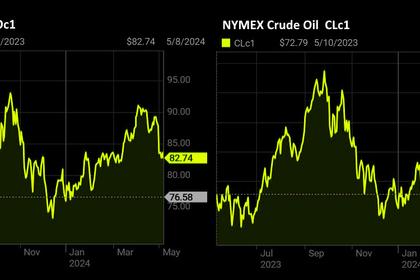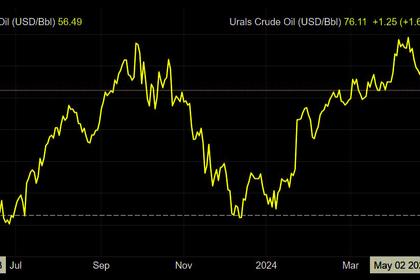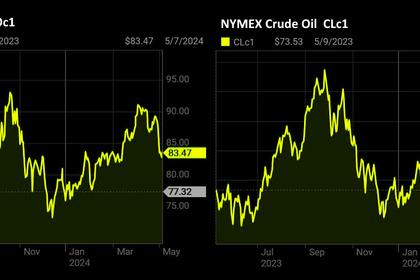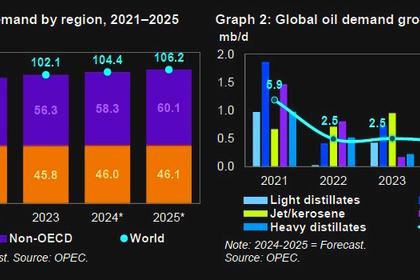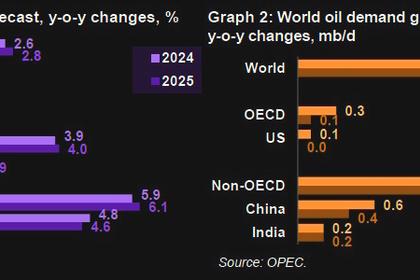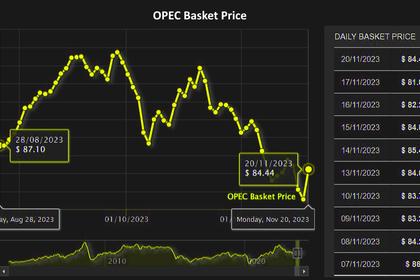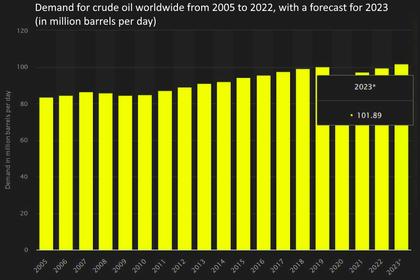
GLOBAL OIL DEMAND +2.2 MBD
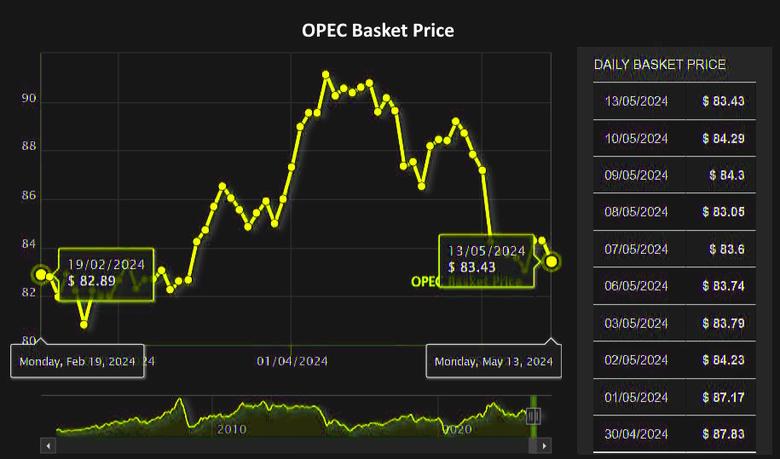
OPEC - May 14, 2024 - OPEC MONTHLY OIL MARKET REPORT
Oil Market Highlights
Crude Oil Price Movements
In April, the OPEC Reference Basket (ORB) value rose by $4.90, or 5.8%, m-o-m, to average $89.12/b. Oil futures prices averaged higher, with the ICE Brent front-month contract increasing by $4.33, or 5.1%, m-o-m to average $89.00/b, and the NYMEX WTI front-month contract rising by $3.98, or 4.9%, to average $84.39/b.
The DME Oman front-month contract rose by $5.12, or 6.1%, m-o-m, to average $89.37/b. The front-month ICE Brent/NYMEX WTI spread widened by 35¢ to average $4.61/b. The market structure of oil futures prices strengthened and money managers remained increasingly bullish about oil. The premium of light sweet to medium sour crudes narrowed across all major trading hubs on lower light distillate margins.
World Economy
The world economic growth forecasts for 2024 and 2025 remain unchanged at 2.8% and 2.9%, respectively.
In the United States, economic growth for 2024 and 2025 are revised up slightly to 2.2% and 1.9%, respectively. The economic growth forecast for the Eurozone remains at 0.5% for 2024 and 1.2% for 2025. Japan’s economic growth forecast is also unchanged at 0.8% in 2024 and 1% in 2025. China’s economic growth forecast remains at 4.8% in 2024 and 4.6% in 2025. India’s economic growth forecast is unchanged at 6.6% for 2024 and 6.3% for 2025. Brazil’s economic growth forecast remains at 1.6% for 2024, and 1.9% for 2025. Russia’s economic growth for 2024 is revised up slightly to 2.3%, while the forecast for 2025 remains at 1.4%.
World Oil Demand
The global oil demand growth forecast for 2024 remains broadly unchanged from last month’s assessment at 2.2 mb/d. There were some minor upward adjustments to 1Q24 data, including a slight upward adjustment in OECD Americas and Chinese data due to better-than-expected performance in oil demand in 1Q24. However, this increase was offset by a downward revision to the Middle East in 2Q24 and 3Q24 due to an anticipated slight decline in these two quarters. Accordingly, the OECD is projected to expand by nearly 0.3 mb/d, while the non-OECD is forecast to grow by about 2.0 mb/d. Global oil demand growth in 2025 is expected to remain robust at 1.8 mb/d, y-o-y, unchanged from the previous month’s assessment. The OECD is expected to grow by 0.1 mb/d, y-o-y, while demand in the non-OECD is forecast to increase by 1.7 mb/d.
World Oil Supply
The non-DoC liquids supply (i.e. liquids supply from countries not participating in the Declaration of Cooperation) is expected to grow by 1.2 mb/d in 2024, unchanged from the previous month’s assessment. The main drivers for growth are expected to be the US, Canada, Brazil and Norway. In 2025, non-DoC liquids supply growth is expected at 1.1 mb/d, broadly unchanged from the previous month’s assessment. Again, growth is mainly driven by the US, Brazil, Canada and Norway.
Separately, DoC natural gas liquids (NGLs) and non-conventional liquids are forecast to grow by about 0.1 mb/d to average 8.3 mb/d in 2024, followed by a minor decline of about 10 tb/d to average 8.3 mb/d in 2025. The DoC crude oil production in April decreased by 246 tb/d, m-o-m, averaging 41.02 mb/d, as reported by available secondary sources.
Product Markets and Refining Operations
In April, refinery margins continued to trend downward as the recovery in refinery processing rates and stronger product output weighed on product markets. Most of the weakness stemmed from falling naphtha and diesel crack spreads due to slightly lower demand, which led to a lengthening balance for corresponding products, particularly in the Atlantic Basin. In Singapore, high middle distillate imports from India contributed to downward pressure on Southeast Asian refining profitability despite limited fuel oil crack spread gains and healthy regional gasoline requirements. Global refinery intake increased by 170 tb/d in April to average 80.0 mb/d compared with 79.8 mb/d in the previous month, but was 1.1 mb/d lower y-o-y.
Tanker Market
Dirty freight rates showed divergent trends in April. Very Large Crude Carrier (VLCC) spot freight rates were softer, with the Middle East-to-East route falling 11% m-o-m. In contrast, Suezmax spot freight rates improved, with the US Gulf Coast-to-Europe route seeing a 3% m-o-m increase. The Aframax market also improved, with intra-Med rates up 15%, although East of Suez rates declined. Rates for clean tankers declined on all reported routes, with East of Suez rates down 10% and West of Suez rates falling 20%.
Crude and Refined Products Trade
Preliminary data shows that US crude imports averaged 6.5 mb/d in April, representing an increase of 4%, m-o-m. US crude exports also moved higher, gaining 6% m-o-m to average 4.2 mb/d. US product imports rose by more than 3% to 6.5 mb/d in April, led by gains in gasoline inflows, while product exports were up by almost 3% supported mainly by outflows of propane/propylene, distillate fuel and jet fuel. The latest data for China shows crude imports continuing to climb, averaging 11.6 mb/d in March, representing an increase of 4%, m-o-m. Product imports into China jumped by over 26%, m-o-m, led by inflows of LPG and fuel oil, while product exports increased by around 33%, due to rising outflows of diesel oil, gasoline and jet fuel. India's crude imports in March recovered much of the previous month’s decline, averaging 4.9 mb/d for a gain of 8%.
India’s product imports fell 13% on lower inflows of LPG. In Japan, crude imports remained relatively flat in March, averaging 2.4 mb/d for a decline of 2%. Japan’s product exports increased by more than 18%, m-o-m, on support from most major products, except LPG. Preliminary estimates indicate OECD Europe crude imports remained relatively steady in April. Product imports into the region were slightly lower, amid a decline in jet fuel imports.
Commercial Stock Movements
Preliminary March 2024 data shows total OECD commercial oil stocks rose by 20.2 mb, m-o-m. At 2,793 mb, they were 121 mb below the 2015–2019 average. Within the components, crude and product stocks were up by 6.8 mb and 13.5 mb, m-o-m, respectively. OECD commercial crude stocks stood at 1,369 mb in March, which is 93 mb less than the 2015–2019 average. OECD total product stocks in March stood at 1,424 mb. This is 27 mb below the 2015–2019 average. In terms of days of forward cover, OECD commercial stocks increased in March by 0.2 days, m-o-m, to stand at 60.8 days. This is 1.7 days less than the 2015–2019 average.
Balance of Supply and Demand
Demand for DoC crude (i.e. crude from countries participating in the Declaration of Cooperation) remains unchanged from the previous month’s assessment to stand at about 43.2 mb/d in 2024, which is around 0.9 mb/d higher than the estimated level for 2023. Demand for DoC crude in 2025 remains unchanged from the previous month’s assessment to stand at 44.0 mb/d, around 0.8 mb/d higher than the level estimated for 2024.
-----
Earlier:
